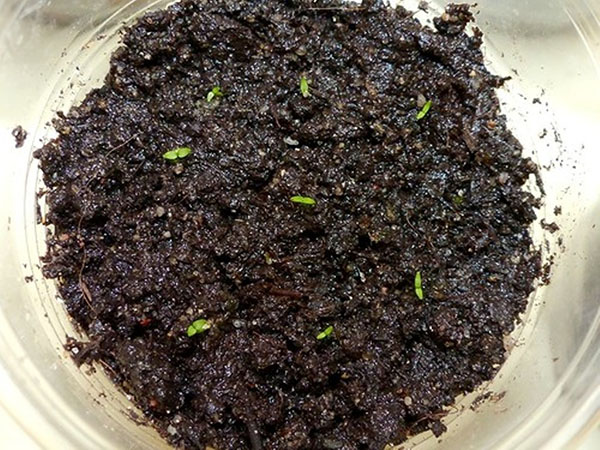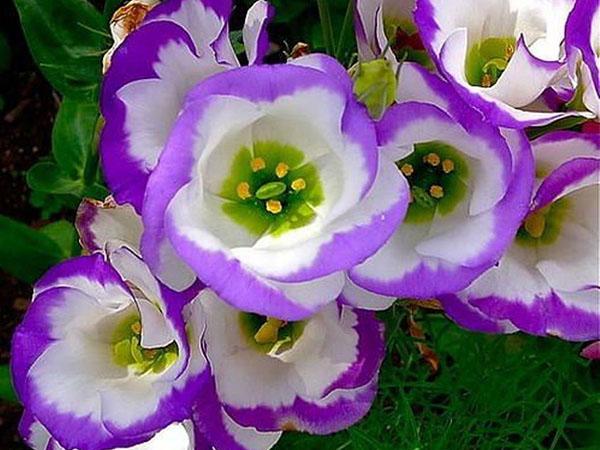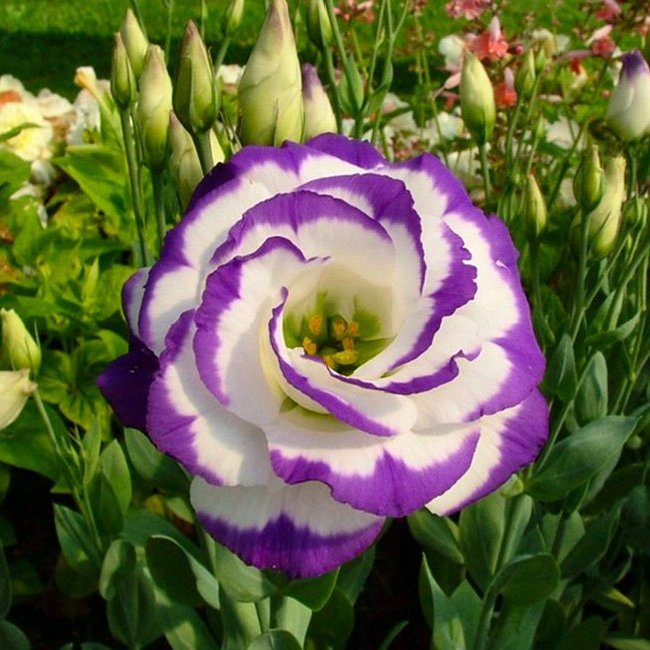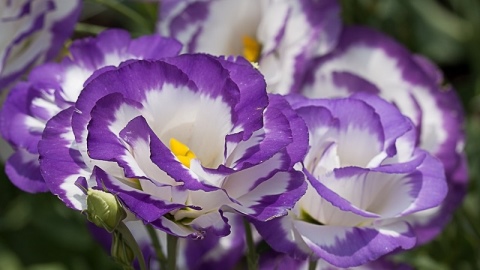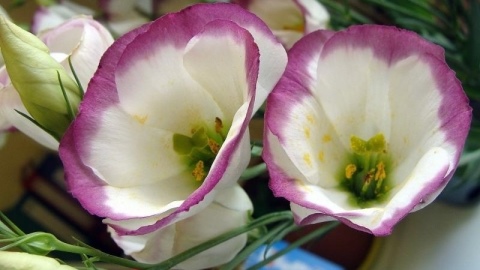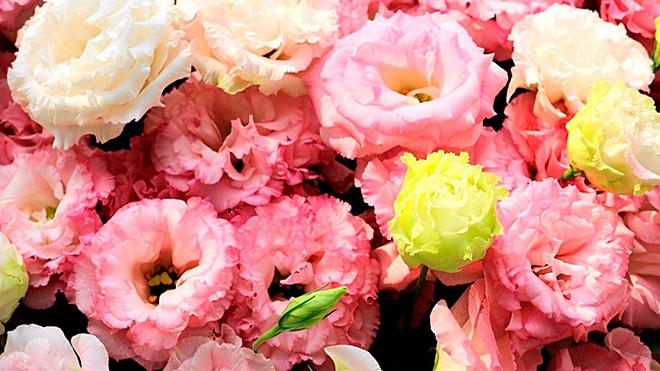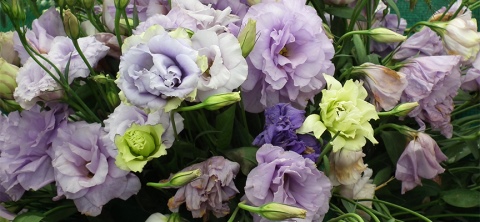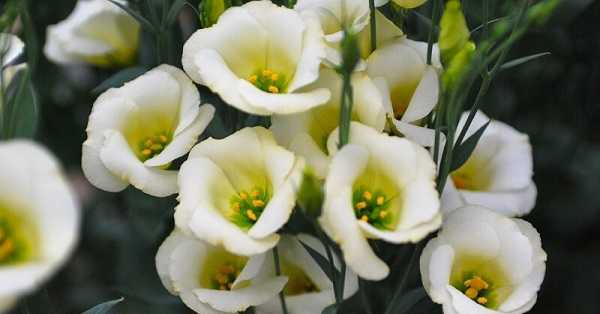Plant care
Eustoma requires special care. Basic care procedures include:
- Watering;
- Loosening the soil;
- Application of mineral and organic fertilizers;
- 4Prevention of diseases and pests.

- 1 Watering.
Watering the plant is required as the soil dries. Watering should not be abundant. In the event that the weather is dry, it is recommended to increase their number.
- 2 Loosening the soil.
It is advisable to weed once every two weeks so that more oxygen penetrates into the soil.
In addition, it is important to get rid of weeds on time.
- 3Application of mineral and organic fertilizers.
The first feeding is carried out after the seedlings have taken root in a new place. It is recommended to do this about a month after the dive. It is advisable to use high-quality mineral fertilizers that are completely soluble in water. For these purposes, you can use a series of dressings for flowering plants "Plantafol". At the beginning of June, it is necessary to add Plantafol Growth with a high nitrogen content to the soil. In July and August "Plantafol Boutonization". In this top dressing, there is already less nitrogen, but more phosphorus. This type of mineral fertilizer from the entire series will promote abundant flowering and the formation of lush buds. Instead of "Pantafol", you can use the fertilizer "Kemira" or "Kemira Lux". It can be used under the root.
- 4Prevention of diseases and pests.
Eustoma is susceptible to diseases such as:
Fusarium wilting.
The disease is caused by fungal bacteria. They develop in the absence of sunlight, high temperatures and high soil moisture. Fusarium wilting is difficult to combat as bacteria live in the soil itself. Affected plants must be removed from the site immediately. The soil should be sprayed with a solution of potassium permanganate and sprinkled with a mixture of ash and sulfur.

Gray rot.
The first sign of gray mold appearance is dark gray spots on the leaves. To cope with this disease, the affected plants must be sprayed with a solution of Bordeaux liquid. Fungicides can also be used. If the leaves are severely affected, then such specimens must be urgently removed from the site so that the fungus does not spread to other crops.
Powdery mildew.
The first sign of powdery mildew is white bloom. It appears on leaves and stems. The cause of powdery mildew is excess moisture. Fungicides can be used to combat the disease.
Various insects can also affect eustoma. Basically, these are wingless, mushroom mosquitoes and aphids. These insects feed on the sap of the plant, which is the reason for its wilting. The leaves begin to turn yellow and fall off. If bugs and larvae appear on the bushes, they urgently need to be treated with insecticides. Larvae and adult insects can be removed by hand.
Perennial eustoma - a whole bunch of one plant
Let's get acquainted, this is a perennial eustoma! Large-flowered eustoma (Eustoma grandiflorum) or lisianthus is a perennial plant, but in our climate it is grown as an annual plant.
Perennial eustoma begins to gradually conquer our hearts and gardens. Large-flowered eustoma flowers come in a variety of colors - white, pink, lilac, violet, white with colored edging, which in their beauty and grace resemble half-open rosebuds.
Eustoma stems are strong, low only up to 50 cm in height, approximately in the middle they begin to branch strongly. Because of this strong branching, one eustoma plant looks like a whole bunch of flowers.Moreover, the stems of the eustoma are not prickly, not like those of a rose. Do you think eustoma will be able to squeeze the rose in our gardens?
It is necessary to sow perennial eustoma seeds at the end of February - March, in order to get flowering in July-August. The seeds of the eustoma are very small, they are sold mainly pelleted, only five pieces each. The technology for germinating eustoma is the same as that of petunia, herb carnation, and lobelia. The surface of the substrate needs to be leveled and slightly, quite a bit, compacted. This is done so that when watering, the eustoma seeds are not washed off the surface, because they germinate only in the light. Then moisten the surface of the substrate from a sprayer, and spread the seeds of eustoma on the wet surface of the soil, cover the crops with glass, or wrap the container with the crops of eustoma in a plastic bag to create a greenhouse effect. Eustoma crops must be constantly ventilated, the resulting condensate removed, and moistened, if necessary, from the sprayer.

At a temperature of +21 + 24 ° C, eustoma shoots appear in 10-12 days. They are very small and it takes a lot of time and patience to grow strong. Gradually, eustoma seedlings, with the appearance of the second true leaf, need to begin to harden. To avoid black leg disease, perennial eustoma seedlings should be periodically sprayed with a solution of phytosporin. In order for the seedlings to develop well, spraying with epin or zircon can be applied. These drugs should not be neglected. They increase the germination of seeds, at the slightest lodging of seedlings, spraying with zircon also prevents the appearance of a black leg. The seedlings become strong and grow quickly. Eustoma seedlings dive at the stage of 2-3 true leaves into separate pots.
Eustoma can be planted in the ground when the threat of frost has passed, for central Russia not earlier than late May - early June. At first, eustoma seedlings need to be shaded so that it can adapt.
Eustoma prefers sunny places where it fully reveals its beauty, cultivated soil filled with humus, fertilizing with mineral fertilizers containing a complex of NPK with trace elements, watering and spraying. Eustoma is becoming so popular and in great demand that it is even grown in industrial greenhouses.
One eustoma makes a real bouquet that can be used as a gift at any celebration. Large-flowered eustoma looks great both in a flower garden in a group planting, and as a soloist, as well as a pot culture for balconies and terraces.
In the fall, perennial eustoma can be transplanted into a pot and grown as a houseplant, placing it in a cool, bright room or winter garden. Do not forget to spray the eustoma more often, and it will be able to delight you with its charming flowers for a long time. And in the spring, you can plant the eustoma again in the open ground.
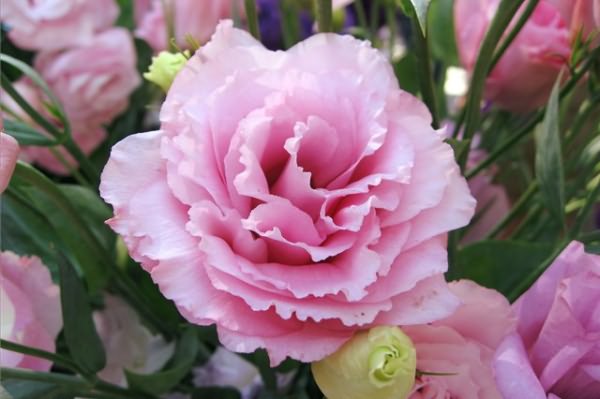
- Planting and caring for eustoma
- Eustoma home care photo
- Eustoma planting care photo
- Eustoma home care
- Eustoma planting by seeds
- Eustoma flower planting and care
- Planting eustoma seeds
- Eustoma flower care
- Eustoma care
- Eustoma care
- Eustoma cultivation care
- Eustoma planting and care at home
- Eustoma cultivation and care at home
- Eustoma cultivation and care in the garden photo
- Eustoma in the garden care
- Blueberries planting and care
We select a place for landing on the site
Growing eustoma flowers involves not too demanding care, but its conditions must still be observed, otherwise the plant will start to hurt
It is especially important to pay attention to the choice of location. Eustoma prefers bright sun, so it should be planted on the south side, which is not shaded by tall trees or nearby buildings. Air movement is necessary (but not cold winds!)
A nutritious and light soil is suitable, in which moisture is evenly distributed.It is recommended to add sifted sand to the soil before planting.
Air movement is necessary (but not cold winds!). A nutritious and light soil is suitable, in which moisture is evenly distributed. It is recommended to add sifted sand to the soil before planting.
Watering the flowers is carried out not too often, the soil should dry out. Overflowing can be very dangerous and the plants often get sick. The water temperature should be at the level of 15-20 degrees, it is impossible to take cold liquid.
Complex liquid fertilizers for open ground are applied only during the growing season.
The flowers grown in the garden must be protected not only from diseases, but also from pests, which quite often affect plants grown in the open field. Among such pests, it is necessary to note thrips, whitefly, spider mites. To prevent infection, regular preventive spraying, examinations of the condition of the flower are required.
Features of planting eustoma in the open field
The optimal time for planting seedlings of plants on the site is the first days of July. In the middle of summer, young specimens will reach maximum readiness for rooting in street soil and will bloom almost immediately.
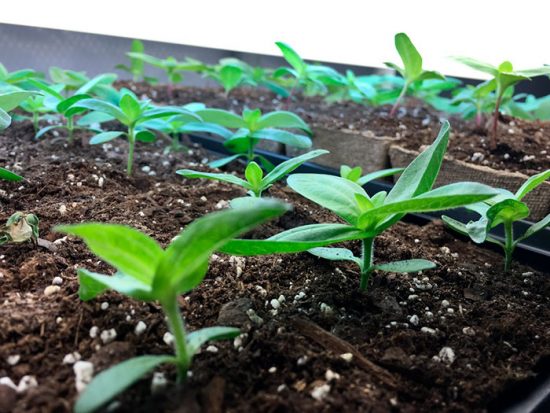 Eustoma shoots
Eustoma shoots
For this to happen, consider the following when landing:
- Choose a place for the eustoma without exposure to midday sunlight - shade or partial shade.
- Do not plant the flower near objects that will reflect the rays of the sun on it.
- The interval between shoots is from 20 cm.
- The culture does not like high humidity and abundant watering. Do not plant it under the edge of a roof canopy or gutter to prevent water from stagnating in the ground when it rains.
- The garden soil at the planting site must have good drainage and a neutral reaction. Wood ash added directly to the holes will help to cope with increased acidity.
- Apply store-bought flower fertilizer or nitrophosphate to the seedling holes.
When is the best time to plant?
When is the best time to plant an Irish rose?

The most favorable time for planting eustoma is in late February - early March.
Seeds planted during this period will be able to sprout quite early, and flowering will begin in July and end only at the end of August.
It is best to sow seedlings from December to January. This is due to the fact that the bush begins to bloom 17-20 days after the first shoots appear, therefore, in order to accelerate the onset of this period, sowing should be done as early as possible.
How to grow eustoma outdoors? The temperature for growing eustoma from seeds should be no more than +20 degrees during the day and +14 degrees at night. Planting dates depend solely on the region and climatic conditions. In the temperate climatic zone, the most favorable time is mid-May, when four to eight leaves will appear on the shoots.

When to sow eustoma for breeding at home? In the event that the eustoma from seeds is grown at home, then sowing should be started from July to September.
Description of eustoma
Also known among flower growers as Lisianthus Russell, Irish, Japanese rose, Texas bell or love rose, eustoma is one of the most beautifully flowering crops. And in horticulture, and in floriculture, it is represented by only one species - large-flowered eustoma (eustoma grandiflorum).
Large-flowered eustoma is a luxurious plant with a height of 30 to 90 cm with branched shoots, simple, elegant leaves with a bluish tint and flowers reminiscent of a hybrid of a rose and a poppy. Up to two dozen large, luxurious flowers bloom on one plant per season, and due to the fact that they do not open simultaneously, but in turn, eustoma retains its attractiveness for an amazingly long time.
The ability of the buds to bloom after the withering of the flowers is also preserved in bouquets: buying an eustoma or displaying it in vases, you can be sure that each bud will turn into a beautiful Japanese rose. Each plant looks like a bouquet: due to the specific branching, strong, but slender, fan-shaped, the eustoma really seems to be a bouquet planted in a pot.
Eustoma bloom depends on the timing of sowing and begins 20 weeks after sowing. In classic garden eustomas, it starts in June-August and lasts until mid-autumn, because the plant will not stop delighting with flowers until the frost reaches -10 degrees and snow falls.
The color palette of eustoma today includes not only white, purple, pink, yellow, orange colors, but also various two-color and watercolor combinations. Compact indoor eustomas have colors that are usually clean and bright enough, while garden ones have a much wider range of colors. It even includes light green, fruity shades.
The huge assortment of eustoma and its popularity all over the world is the merit of the breeders of the USA and Japan. In the west, this plant is one of the most popular cut species, but in our country this Japanese beauty is slowly gaining ground.
 Bouquet of eustomas. ekenitr
Bouquet of eustomas. ekenitr
Reproduction of osteospermum
The full description of planting and caring for osteospermum indicates that it does not tolerate frost, a sharp drop or increase in temperature at night and during the day. In areas with warm climates, the plant can grow for several years in open ground or in flowerpots on verandas.
Growers prefer to propagate osteospermum using a vegetative method or seed. For cultivation of varietal hybrids, cuttings are better suited, since the daughter plant in this case receives all the specific characteristics of its variety.
Growing osteospermum from seeds
The main thing to know when growing osteosperm from seeds - when to plant it for seedlings. As a rule, this is done at the end of winter or at the beginning of spring. Seeds are sown in plastic cups or general containers. The soil is abundantly moistened, and the container is covered with plastic wrap and sent to a warm room.
In the spring, after warming up the soil, you can sow the crop directly into the open ground. In any case, the seeds are only slightly pressed into the soil. Their deep burial can cause them not to germinate. Experienced gardeners plant pre-cleaned material with peeled off the upper skin or cracks made on it, which promotes the absorption of moisture by the grains and, therefore, more rapid emergence of sprouts.

Growing from seeds
After the appearance of the first sprouts, the film is removed from the containers. It is recommended to harden young plants before planting in open ground. To do this, they are sent to fresh air during the daytime, each day increasing the time spent in the sun to 5-6 hours. Plants are hardened for two weeks. After that, it will be easier for them to endure the nighttime temperature drop. Seedlings are planted in open ground after the end of frost on the soil.

Transplant to open ground
Propagation by cuttings
For grafting, the mother shrub is transferred from autumn to home conditions and kept in a warm room at a temperature of + 12-15 degrees. The soil is regularly moistened, avoiding drying out.
Cuttings are cut from the top of the shoots and sent to the water. In it, they quickly release roots and easily root in loose and nutritious soil. If grafting is carried out from indoor individuals, then cutting is done from non-flowering shoots.
Important! For good rooting, the cut is carried out a month before planting.
Perennial eustoma after flowering, what to do
Eustomia flowers photo, which shows all its beauty, after flowering goes into hibernation.During this period, all metabolic processes slow down, and the plant practically does not grow. From now on, stop fertilizing the flower, reduce its watering and lower the temperature in the room a little. If you want it to please you with lush flowering again a year later, be sure to cut off all the shoots, leaving no more than 3 special points.
Irish rose, what to do in winter?
Lisianthus is afraid of frosty days, so you need to carefully prepare it for winter. Be sure to move the shrub to the container and transfer it to the loggia.
growing in the Urals or Siberia This method is most popular for these cold regions.
When choosing to grow eustoma in a greenhouse for cutting in Siberia, it is even better. This method helps to get flowering shrubs much earlier than when breeding it in the usual way. Be sure to provide the plant with light. If there is a lack of natural light, create and add artificial light. Fluorescent lamps do the job perfectly. Thanks to this, you will be able to grow a healthy perennial specimen that will delight you with lush flowering.
How to grow a houseplant at home
If you have grown eustoma in the garden, cultivation and maintenance in an apartment will not be difficult. It will effectively look on the windowsill and decorate any room.
- For planting in pots, only dwarf specimens are used.
- It is better to install the container on the west or east window, where bright diffused lighting will prevail. If you decide to put the pot on the southern windowsill, be sure to shade the window pane.
- It is worth abandoning the cultivation of a bush on the northern side of the building, because the lack or lack of sunlight will lead to a slowdown in development and growth.
- If you purchased an adult plant, then it is necessary to accustom it to the sun's rays gradually, as they can harm its foliage.
Planting perennial eustoma seedlings in open ground
Seedlings are pre-dived, placing them in intermediate pots (again, it is good to take peat ones) when they grow up to 5-6 centimeters.
Before planting on the street, we harden the seedlings. This is a mandatory procedure. In two weeks, we begin to accustom the seedlings to coolness, taking them out to the veranda or balcony for several hours.
Important! We plant a plant in a garden only when return frosts recede
We place the bed in partial shade or in a place with diffused light;
The soil is dug up, loosened, the hole is watered very abundantly;
Loose, drained soil is the key to planting success;
The distance between the holes is 20 centimeters;
We put the plants in peat pots or carefully transfer them along with a lump of earth;
Sprinkle, compact the soil and refrain from watering.
Supports for weak plants can be installed immediately, and can also be covered with plastic containers.






